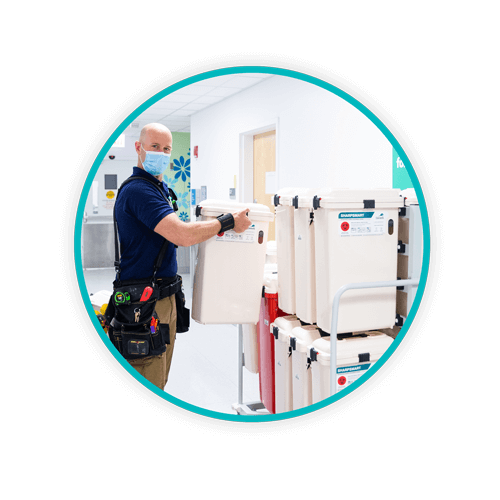Take Control of Your Hospital Waste Management with Daniels’ Self-Service Model

At Daniels Health, we understand that no two healthcare facilities are the same. From the physical layout of the building to the procedures performed, along with the various roles and responsibilities of on-site faculty – every facility has unique requirements. These factors and more influence hospital waste management and can sometimes create challenges in developing a safe and reliable waste program. For that reason, we work with you to develop a waste management service approach that makes the most sense for your individual facility needs. Put simply – our goal is to provide flexibility that doesn’t compromise safety or compliance. In fact, we offer a “self-service” waste model that eliminates relying on an outside vendor to service your waste. We can provide this unique industry offering because of one critical reason – our clinically tested, safe container design.
This blog will explain what a self-service waste model looks like and why it’s a safe and reliable approach for your healthcare facility.
TOPICS WE WILL COVER:
1 / What is a “self-service” waste model?
2 / How Daniels ensures self-service safety
3 / What are self-service model benefits?
4 / Self-service success stories
5 / Our self-service alternatives
What is a “self-service” waste model?
A self-service model empowers your existing staff – Environmental Services, Facilities, etc. – to remove and exchange sharps, chemotherapy, and pharmaceutical waste containers themselves. This entails staff removing full waste containers and replenishing them with fresh, sanitized containers.
Empowering EVS and hospital staff to facilitate container exchanges, a self-service model lowers costs and reduces unneeded complexity of labor and movement. Hospital staff can exchange containers on-demand rather than having containers exchanged prematurely due to vendor staff hours. Patient interruptions are reduced with the elimination of surplus labor and container-utilization checks.
Critically, this model is only possible with safe containers that do not pose a risk to healthcare workers.
How Daniels ensures self-service safety
Managing the removal and exchange of Daniels containers poses zero threat to staff safety thanks to the innovative safety features built into our containers. Daniels’ safety features effectively eliminate container-related needlestick injuries for frontline healthcare workers.
We don’t just say our containers are safe. We have clinical research to back it up. Our devices are made with ABS plastic and a safety-engineered construction designed to be:
- Impenetrable by sharps
- Leakproof
- Spillproof
-
Tamperproof
There are 23 total safety features built into Daniels’ Sharpsmart sharps container, including a gravity-balanced safety tray that automatically locks into a “FULL” position once the container is full; concealing the container opening and eliminating the risk of container-overfill.
All of Daniels’ containers have a permanent locking feature for enhanced safety when the container reaches capacity. Once this locking feature is engaged, no one can access the container contents until it is received at one of our treatment facilities.
Our containers have a 100% inbuilt design. This means they can operate as standalone units with no cabinets needed. Your staff only needs to handle the container unit itself. You can learn more about our mission and commitment to safety here.
What are the benefits of a self-service model?
A self-service sharps container exchange model impacts hospitals in the following ways:
- Patient Safety – Safety, cleanliness and infection control are paramount in any healthcare facility. By empowering your staff to self-service waste, you avoid having non-hospital staff interface with clinical care when exchanging containers.
- Cost Savings – Your waste management costs are determined by the number of container exchanges, waste pickups, and labor requirements. By engaging your full-time staff to take charge of container exchanges, you eliminate paying vendor-contracted services and cost of extra headcount. We have helped customers save up to $290,000 annually by bringing this labor in-house.
- Utilizing full-time staff optimally – Full-time staff are already accounted for in your budget. By utilizing staff for container servicing, you can build productivity and efficiency into their schedule. You also empower staff to manage and understand the waste you generate, which reinforces proper waste segregation education.
- Improving container fill rates – Self-service is the best option to maximize device efficiency. Daniels’ Sharpsmart containers have a significant competitive advantage over comparative sharps containers in fill efficiency and usable capacity. The design of the gravity-based safety tray of the Sharpsmart container ensures sharps are deposited horizontally to maximize volume, and the total capacity to the fill line is true volume utilization. This equates to less containers exchanged, and less service hours. Self-service further improves fill utilization rates because staff members can pull the containers when they’re full – on any given day of the week. Compare this to an outside vendor who is only able to service a given facility for a limited number of days and hours allocated to service. Additionally, if your containers do not have Overfill Protection they are typically exchanged when they are around 75% full to eliminate risk of overfilling between services. This 25% underutilized capacity has a significant impact on disposal costs.
-
Reducing container exchanges – With improved container fill rates, you’ll have fewer container exchanges, less patient interruptions, and less waste pickups – equating to an immediate cost and environmental impact for your hospital.
Self-Service Success Stories
Every hospital we have partnered with to convert from a sharps container “Vendor-Exchange” to a “Hospital-Exchange” (i.e., self-service) model has seen significant improvements in container fill-level optimization, which thereby has driven reductions in cost, labor dependency, and hospital interruptions. Additionally, it has equipped hospitals to drive even further cost efficiencies through better understanding of waste disposal practices at a department level.
Increased Container Fill Rates
 With two of our customers, we saw significant increases in fill-level optimization through conversion from vendor-exchange service to self-service by 8% and 41%, respectively.
With two of our customers, we saw significant increases in fill-level optimization through conversion from vendor-exchange service to self-service by 8% and 41%, respectively.
Specific wins included:
- With staff on site every day, premature exchanges of partially filled containers were lessened.
- EVS managers could train and monitor behavior daily, driving best-practices at a departmental level.
-
Stronger focus could be put on the higher cost waste streams, driving significant cost savings through container turn reduction.
Reduced Costs
Improved container fill rates and the elimination of additional service staff translates to significant cost savings. Our partners have seen annual waste management costs reduced by up to $290,000 using a self-service model.
Specific cost-reduction drivers included:
- All service staff being trained to swap out containers.
- Eliminating container shortages in clinical areas (especially during non-serviceable hours).
- Reduction in non-essential staff within clinical environments (especially where donning PPE is required).
-
Eliminating costs of third-party service personnel and container turn reduction.
Our Self-Service Alternatives
For facilities that don’t have staff available to exchange their own containers, we offer a Premium Service Model. A Premium Service model engages our dedicated Field Service Representatives who regularly service your facility to remove full waste containers and replenish them with robotically sanitized containers.
How it works - Daniels Health personnel will service your facility room-to-room during agreed upon hours and track the containers to the department level for reporting purposes. Our Field Service Representatives manage the movement of containers from each disposal location to the hospital loading dock, as well as the storage and staging of containers for transport. This model eliminates reliance on staff for waste servicing.
Final Thoughts
Our goal at Daniels Health is first and foremost safety.
Part of our safety mission is not only in providing the safest sharps and medical waste containers for US hospitals, but providing a system that enhances efficiencies, minimizes labor burden, and mitigates risk in patient care. Our self-service waste movement model epitomizes this: less staff, fewer touches, lower risk. If you are looking to reduce costs or waste movement labor overages at your hospital, talk to one of our clinical experts to explore what a transformative self-service waste management model would look like.
Interested in exploring a self-service waste model? Talk to us!
